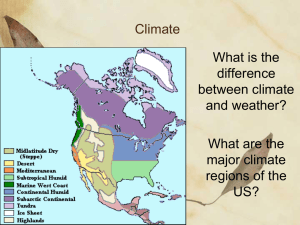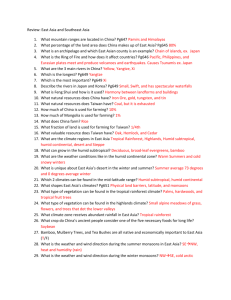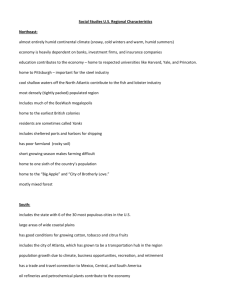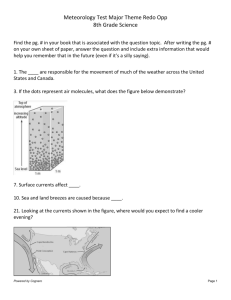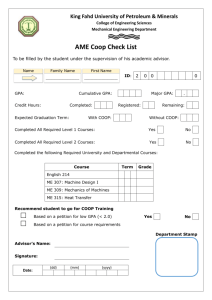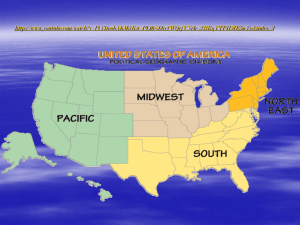Supplementary Material Environmental stability and the evolution of
advertisement
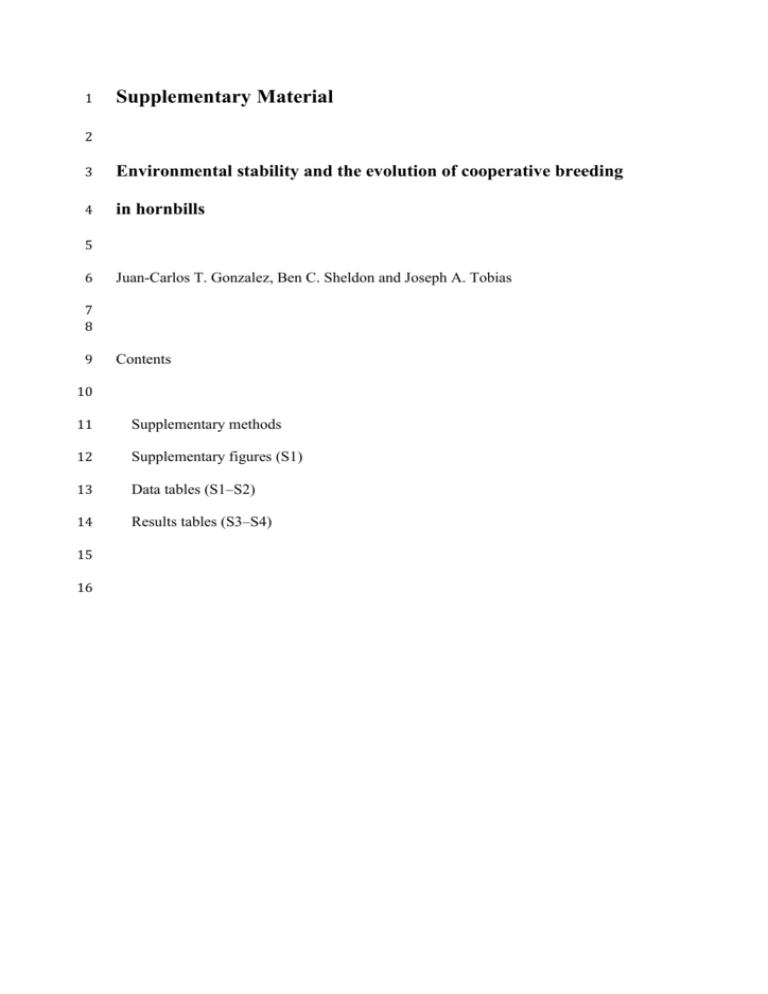
1 Supplementary Material 2 3 Environmental stability and the evolution of cooperative breeding 4 in hornbills 5 6 Juan-Carlos T. Gonzalez, Ben C. Sheldon and Joseph A. Tobias 7 8 9 Contents 10 11 Supplementary methods 12 Supplementary figures (S1) 13 Data tables (S1–S2) 14 Results tables (S3–S4) 15 16 17 Supplementary methods 18 19 Testing for co-evolution between cooperative breeding and other intrinsic traits 20 We reconstructed the evolution of cooperative breeding in 25 cooperatively 21 breeding species of hornbill using the module DISCRETE [1] of BAYESTRAITS 22 [2]. This method determines whether two traits are more likely to have evolved in 23 tandem on the basis of the frequency of transitions between the different combined 24 states. It first reconstructs the most likely scenario if two traits evolved 25 independently in the phylogenetic tree and compares this with a scenario in which 26 the two traits are linked in the four possible combinations and where the transitions 27 occur at random. The evolution of characters across the phylogeny was 28 reconstructed assuming both independent and dependent evolution of the two states. 29 Significance of results was measured by performing a likelihood ratio test, 30 comparing twice the difference between the independent and dependent model to a 31 chi-square test with four degrees of freedom to reflect the higher number of 32 parameters in the dependent model. 33 34 Additional phylogenetic comparative analyses 35 We tested whether our results were robust to alternative phylogenetic modelling 36 approaches by conducting phylogenetic independent contrasts (PIC) and 37 phylogenetic-generalized least squares (PGLS) analyses. PICs corrected for branch 38 length were generated using the function ‘pic’ of the package APE [3] in R, using a 39 recently published phylogeny of hornbills [4]. The contrasts of all intrinsic and 40 extrinsic variables were tested against contrasts in cooperative breeding in linear 41 regressions in which the intercept is forced to pass through zero (using the ‘lm’ 42 function in R). PGLS, meanwhile, uses maximum likelihood to estimate the most 43 likely transformation of branch lengths according to Pagel’s lambda to explain the 44 evolution of cooperative breeding while assessing an association with potential 45 predictors. PGLS analyses were implemented using the package ‘CAPER’ [5] in R. 46 47 Supplementary Figures 48 49 50 51 Figure S1. The relationship between social system and body mass for (a) 52 cooperative breeding hornbills (n = 25) and (b) non-cooperative hornbills (n = 36). 53 Sources for mass data are given in table S1. Tukey box plots summarise these data 54 for a single axis. 55 56 Supplementary Tables 57 Table S1. Social system and ecological traits of hornbills Social Preferred Primary Terri- Nest Body system habitat diet toriality hole mass Aceros cassidix Non Humid Frug NonT 1049 2360 Aceros nipalensis Non Humid Frug NonT 350a 2385 Anorrhinus austeni Coop Humid Frug Terr 350a 1079.5 Anorrhinus galeritus Coop Humid Frug Terr 195 1172 Anorrhinus tickelli Coop Humid Frug Terr 350a 792.6 Anthracoceros albirostris Non Humid Frug Terr 226 892.9 Anthracoceros coronatus Non Humid Frug Terr 350a 806.7 Anthracoceros malayanus Coop Humid Frug Terr 350a 1050 Anthracoceros marchei Coop Humid Frug Terr 350a 750 Anthracoceros montani Coop Humid Frug Terr 200a 714.6 Berenicornis comatus Coop Humid Frug Terr 350a 1470 Buceros bicornis Non Humid Frug NonT 567 2790.8 Buceros hydrocorax Coop Humid Frug NonT 385 1409.6 Buceros rhinoceros Coop Humid Frug NonT 600a 2371.6 Bucorvus abyssinicus Coop Dry NonF Terr 600a 4000 Bucorvus leadbeateri Coop Dry NonF Terr 600a 3743.6 Bycanistes albotibialis Non Humid Frug NonT 350a 1137.8 Bycanistes brevis Non Dry Frug NonT 350a 1232.8 Bycanistes bucinator Coop Dry Frug NonT 200a 639.4 Bycanistes cylindricus Non Humid Frug NonT 98 921 Bycanistes fistulator Coop Humid Frug NonT 115a 508.1 Bycanistes subcylindricus Coop Humid Frug NonT 350a 1195.4 Ceratogymna atrata Coop Humid Frug NonT 130 1194.8 Ceratogymna elata Coop Humid Frug NonT 350a 1917 Lophoceros alboterminatus Non Humid Frug Terr 115a 223.7 Taxon Lophoceros bradfieldi Non Dry NonF Terr 115a 196.5 Lophoceros camurus Coop Humid NonF Terr 115a 103.8 Lophoceros fasciatus Non Humid Frug Terr 115a 258.8 Lophoceros hemprichii Non Dry NonF Terr 200a 297 Lophoceros nasutus Non Dry NonF Terr 200a 179.6 Lophoceros pallidirostris Non Dry NonF Terr 115a 233 Ocyceros birostris Coop Dry Frug Terr 115a 375 Ocyceros gingalensis Coop Humid Frug Terr 115a 238 Ocyceros griseus Non Humid Frug Terr 70 292 Penelopides affinis Coop Humid Frug Terr 200a 456 Penelopides manillae Coop Humid Frug Terr 176 460.9 Penelopides mindorensis Coop Humid Frug Terr 200a 462 Penelopides panini Coop Humid Frug Terr 169 470.5 Penelopides samarensis Coop Humid Frug Terr 200a 478.4 Rhabdotorrhinus corrugatus Non Humid Frug NonT 350a 1590 Rhabdotorrhinus exarhatus Coop Humid Frug Terr 300a 370 Rhabdotorrhinus leucocephalus Non Humid Frug NonT 350a 1086 Rhabdotorrhinus waldeni Non Humid Frug NonT 350a 1748.8 Rhinoplax vigil Non Humid Frug Terr 600a 2887.6 Rhyticeros everetti Non Humid Frug NonT 672 1748.8 Rhyticeros narcondami Non Humid Frug NonT 756 697.2 Rhyticeros plicatus Non Humid Frug NonT 350a 1703.8 Rhyticeros subruficollis Non Humid Frug NonT 350a 2042 Rhyticeros undulatus Non Humid Frug NonT 324 2214.6 Tockus damarensis Non Dry NonF Terr 115a 192.5 Tockus deckeni Non Dry NonF Terr 115a 169.5 Tockus erythrorhynchus Non Dry NonF Terr 115a 154 Tockus flavirostris Non Dry NonF Terr 115a 216.7 Tockus jacksoni Non Dry NonF Terr 115a 167.7 Tockus kempi Non Dry NonF Terr 115a 138.6 Tockus leucomelas Non Dry NonF Terr 115a 188.3 Tockus monteiri Non Dry NonF Terr 144 289.8 Tockus ruahae Non Dry NonF Terr 115a 126.5 Tockus rufirostris Non Dry NonF Terr 115a 134.3 Horizocerus albocristatus Non Humid Frug Terr 200a 289.4 Horizocerus hartlaubi Non Humid NonF Terr 115a 98.5 58 Taxonomy follows Gonzalez et al. [4] with subsequent corrections. 59 Abbreviations: Coop: Cooperative breeding; Non: Non-cooperative breeding; 60 Humid: Humid forests; Dry: Drylands; Frug: Frugivorous; NonF: Non- 61 frugivorous; Terr: Terrtorial; NonT: Non-Territorial. 62 Primary sources: Habitat [6, 7]; Diet [6], with updates by [8, 9]; Territoriality [6, 7, 63 10, 11]; Nest hole size [12-19], and J. C. Gonzalez, unpublished data; Body mass 64 [20]. 65 66 a Data inferred from Galama et al. [21]. 67 Table S2. Climatic variables extracted from hornbill range polygons by Jetz & 68 Rubenstein [22], with data for six other species generated using the same methods. Mean annual Temp. var. Temp. var. Mean annual Ppt. var. Ppt. var. Taxon temp. within years between years ppt. within years between years Aceros cassidix 25.3 1.1 1.1 2089.5 1.5 1.1 Aceros nipalensis 21.6 10.5 1.7 1889.7 5.9 1.9 Anorrhinus austeni 23.9 9.8 1.8 1751.8 5.5 1.7 26 1.2 1.1 2734.6 1.3 0.9 Anorrhinus tickelli 23.1 4.3 1.6 1998.4 7.4 2.4 Anthracoceros albirostris 24.8 7 1.6 2169.8 4.5 1.8 Anthracoceros coronatus 26 9.4 1.7 1461.7 9.7 3.8 Anthracoceros malayanus 26 1.1 1.1 2761.1 1.2 0.9 Anthracoceros marchei 26.9 1.9 1.3 2135.1 2.5 1 Anthracoceros montani 26.8 1.1 1.4 1872.5 1.3 1.3 Berenicornis comatus 24.3 1.2 1.2 1584.1 1.5 1 Buceros bicornis 24.6 7.4 1.7 2067.7 5.6 1.9 Buceros hydrocorax 25.9 2.6 1.4 2655.1 2.6 1.2 Buceros rhinoceros 25.9 1.1 1.1 2743.8 1.4 1 Bucorvus abyssinicus 25.3 6.2 1.9 1013.5 12.1 3.6 Bucorvus leadbeateri 21.8 6.8 1.7 961.8 11.3 3.2 Bycanistes albotibialis 24.6 2.8 1.5 1770.7 5.5 1.9 Bycanistes brevis 21.7 5.1 1.5 982.5 5.9 2.4 Bycanistes bucinator 22.1 6.1 1.6 1015.6 10.3 3 Bycanistes cylindricus 25.8 2.5 1.3 2069.3 4.4 1.5 Bycanistes fistulator 24.8 2.8 1.3 1736 5.7 1.7 Bycanistes subcylindricus 23.8 2.8 1.5 1491.9 5.5 1.9 Ceratogymna atrata 24.6 2.4 1.3 1771 4.4 1.4 Ceratogymna elata 26.2 3.4 1.3 2033.9 7.3 2.3 Lophoceros alboterminatus 22.2 5.4 1.5 1033.8 9.1 2.7 Lophoceros bradfieldi 21.6 10.8 2.4 571.2 15.9 4.5 Lophoceros camurus 24.8 2.4 1.3 1836.4 3.8 1.3 Lophoceros fasciatus 25 2.8 1.4 1719.3 5.9 1.8 22.4 4.5 1.7 725.8 6 3.1 Anorrhinus galeritus Lophoceros hemprichii Lophoceros nasutus 24.2 7 1.9 830 11.4 3.6 Lophoceros pallidirostris 22.2 5.6 1.5 1182.9 11.9 3.2 Ocyceros birostris 25.6 13.2 1.9 1127.5 9.6 4.3 Ocyceros gingalensis 27.1 3.1 1.5 1755.5 2.4 1.8 Ocyceros griseus 25.8 5.5 1.4 1835.8 12.7 3.9 Penelopides affinis 25.8 1.7 1.4 2650.6 1.4 1 Penelopides manillae 25.9 3.6 1.4 2739.5 4 1.5 Penelopides mindorensis 26.4 2.6 1.4 2421.2 3.8 1.6 Penelopides panini 26.9 2.2 1.2 2448.6 2.1 1.2 Penelopides samarensis 26.5 2.3 1.2 2644.9 1.4 1.1 Rhabdotorrhinus corrugatus 25.9 1.1 1.1 2776.3 1.2 0.9 Rhabdotorrhinus leucocephalus 25.7 1.5 1.5 2697.7 1.4 1 Rhabdotorrhinus exarhatus 24.8 1.1 1.1 2127 1.5 1.1 Rhabdotorrhinus waldeni 26.8 2.1 1.2 2419.5 2.4 1.3 26 1.2 1.1 2754.5 1.3 0.9 25.9 2.3 1.3 2776.3 4.1 1.8 27 2 1.5 2980 4.6 1.9 Rhyticeros plicatus 25.3 1.5 1.5 2856.5 1.1 0.9 Rhyticeros subruficollis 24.7 4.7 1.5 2363.8 7.2 2.5 Rhyticeros undulatus 25.2 5 1.5 2342.6 4 1.5 Tockus damarensis 20.9 9.1 2.1 527.1 13.8 4.8 Tockus deckeni 23.9 3.5 1.5 613.5 7.2 3.3 Tockus erythrorhynchus 24.1 7.8 2 686.5 12.2 4 Tockus flavirostris 24.7 4.5 1.6 480.3 7.1 3.5 Tockus jacksoni 25.5 4.5 1.6 595.3 7.1 3.5 Tockus kempi 26.6 6.2 1.9 266.2 12.1 3.6 Tockus leucomelas 20.9 11.2 2.2 539.6 12.1 4.3 Tockus monteiri 20.4 9.1 2.1 360.3 13.8 4.8 Tockus ruahae 21.2 4.5 1.6 1002 7.1 3.5 Tockus rufirostris 21.3 11.2 2.2 754.7 12.1 4.3 25 2.5 1.3 1860.5 4.1 1.4 24.9 2.3 1.3 1795 3.6 1.2 Rhinoplax vigil Rhyticeros everetti Rhyticeros narcondami Horizocerus albocristatus Horizocerus hartlaubi 69 70 Table S3. Correlates of cooperative breeding in hornbills using alternative 71 phylogenetic modelling approaches Modelling approach PGLS PIC Variablesa Estimate ± SE t Estimate ± SE F1,59 Preferred habitat 0.012 ± 0.178 0.065 0.012 ± 0.178 0.004 Primary diet 0.07 ± 0.261 0.268 0.07 ± 0.262 0.072 Territoriality 0.524 ± 0.213 2.464* 0.524 ± 0.213 6.071 Body mass -0.175 ± 0.097 -1.804 -0.175 ± 0.097 3.254 Mean annual temp. 0.502 ± 0.689 0.729 0.502 ± 0.689 0.532 Mean annual ppt. 0.042 ± 0.137 0.306 0.042 ± 0.137 0.093 Temp. var. within yrs -0.178 ± 0.075 -2.372* -0.178 ± 0.075 5.627* Temp. var. among yrs -0.517 ± 0.318 -1.628 -0.517 ± 0.318 2.65 Ppt. var. within yrs -0.179 ± 0.078 -2.289* -0.179 ± 0.078 5.239* Ppt. var. among yrs -0.29 ± 0.127 -2.278* -0.29 ± 0.127 5.191* 72 Bold denotes significant effect of variable on occurrence of cooperative breeding 73 74 *p < 0.05 75 76 77 78 79 80 81 82 83 84 85 86 87 88 89 90 91 92 93 94 95 96 97 98 99 100 101 102 103 104 105 106 107 108 109 110 111 112 113 114 115 116 117 118 119 120 121 122 123 124 125 126 127 Supplementary references 1 2 3 4 5 6 7 8 9 10 11 12 13 14 15 16 17 18 19 20 Pagel M., Meade A. 2006 Bayesian analysis of correlated evolution of discrete characters by reversible-jump Markov chain Monte Carlo. Am. Nat. 167, 808825. Pagel M. 1999 Inferring the historical patterns of biological evolution. Nature 401, 877–884. Paradis E., Claude J., Strimmer K. 2004 APE: analyses of phylogenetics and evolution in R language. Bioinformatics 20, 289−290. Gonzalez J.C.T., Sheldon B.C., Collar N.J., Tobias J.A. 2013 A comprehensive molecular phylogeny for the hornbills (Aves: Bucerotidae). Mol. Phylogenet. Evol. 67, 468-483. Orme D., Freckleton R., Thomas G., Petzoldt T., Fritz S., Isaac N., Pearse W. 2012 Caper: Comparative Analyses of Phylogenetics and Evolution in R, version 5. Kemp A.C. 2001 Family Bucerotidae (Hornbills). In Handbook of the Birds of the World. Vol. 6. Mousebirds to Hornbills (eds. del Hoyo J., A. Elliott A., Sargatal J.), p. 436−523. Barcelona, Spain, Lynx Edicions. Kinnaird M.F., O’Brien T.G. 2007 The ecology and conservation of Asian hornbills: farmers of the forest. Chicago, Illinois, University of Chicago Press. Carrière S.M., Andrè M., Letourmy P., Olivier I., McKey D.B. 2002 Seed rain beneath remnant trees in a slash-and-burn agricultural system in southern Cameroon. J. Trop. Ecol. 18, 353−374. Kitamura S. 2011 Frugivory and seed dispersal by hornbills (Bucerotidae) in tropical forests. Acta Oecologica 37, 531−541. Johns A.D. 1987 The use of primary and selectively logged rainforest by Malaysian hornbills (Bucerotidae) and implications for their conservation. Biological Conservation 40, 179–190. Kemp A.C. 1985 Bird families of the world. The Hornbills: Bucerotiformes. Oxford, U. K., Oxford University Press. Hussain S.A. 1984 Some aspects of the biology and ecology of Narcondam Hornbill (Rhyticeros narcondami). J. Bombay Nat. Hist. Soc. 81, 1–18. Mudappa D.C., Kannan R. 1997 Nest-site characteristics and nesting success of the Malabar Gray Hornbill in the southern Western Ghats, India. Wilson Journal of Ornithology 109, 102 - 111. Marsden S.J., J. M.J. 1997 The nesting requirements of the parrots and hornbill of Sumba, Indonesia. Biological Conservation 82, 279–287. Klop E., Curio E., Lastimoza L.L. 2000 Breeding biology, nest site characteristics and nest spacing of the Visayan Tarictic Hornbill Penelopides panini panini on Panay, Philippines. Bird Conservation International 10, 17–27. Stanback M., Richardson D.S., Boix-Hinzen C., Mendelsohn J. 2002 Genetic monogamy in Monteiro’s hornbill, Tockus monteiri. Animal Behaviour 63, 787– 793. Cahill A.J. 2003 Nest-site characteristics of the Red-knobbed Hornbill Aceros cassidix and Sulawesi Dwarf Hornbill Penelopides exarhatus. Ibis 145, E97E113. Datta A., Rawat G.S. 2004 Nest-site selection and nesting success of three hornbill species in Arunachal Pradesh, North-East India: Great Hornbill Buceros bicornis, Wreathed Hornbill Aceros undulatus and Oriental Pied Hornbill Anthracoceros albirostris. Bird Conservation International 14, S39-S52 Stauffer D.J., Smith T.B. 2004 Breeding and nest site characteristics of the Black-casqued Hornbill Ceratogymna atrata and White-thighed Hornbill Ceratogymna cylindricus in South-central Cameroon. Ostrich 75, 79–88. Dunning J.B. 2008 CRC Handbook of Avian Body Masses. Boca Raton, Florida, CRC Press. 128 129 130 131 132 133 134 21 22 Galama W., King C., Brouwer K. 2002 EAZA hornbill management and husbandry guidelines. Amsterdam, National Foundation for Research in Zoological Gardens. Jetz W., Rubenstein D.R. 2011 Environmental uncertainty and the global biogeography of cooperative breeding in birds. Current Biology 21, 72-78.


